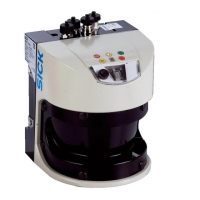3 SYSTEM DESCRIPTION
8017768/12AX/2019-05-31|SICK
OPERATING INSTRUCTIONS | TIC
Subject to change without notice
Downloading vehicle data from the Traffic Controller via FTP
Both csv files and vehicle files can be downloaded from the Traffic Controller via FTP by
using an FTP client on the customer network.
For this reason, the Traffic Controller has an integrated FTP server. This FTP server is
accessed via the client user account with the corresponding password (see also chapter
9.5.5 User data for accessing the FTP server of the Traffic Controller).
Fig. 40: Downloading vehicle data via FTP
Transferring vehicle data directly to an external storage medium
The FTP Export and UNC Export plug-ins do not allow you to save the vehicle data
permanently on the Traffic Controller. Instead, they are used to transfer the data directly
to an external storage medium.
• The FTP Storage plug-in works in a similar way to the Disk Storage plug-in by
generating vehicle files in the vehicle format. It then uploads these automatically to a
customer FTP server. For this reason, the Traffic Controller has an integrated FTP client.
The connection settings for the FTP server are stored in the plug-in itself.
Fig. 41: Automatically uploading vehicle data to a customer FTP server
• The UNC Storage plug-in also creates vehicle files in the vehicle format, but it saves
these in a UNC path. Entering a UNC path (Universal Naming Convention) allows a
directory in a network to be accessed without the need for a drive letter. The UNC path
does not need to be visible in Windows Explorer. Windows shared folders can also be
used as UNC destinations. The storage location is specified in the plug-in itself.
Fig. 42: Automatically saving vehicle data in a UNC directory

